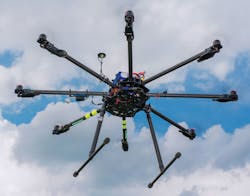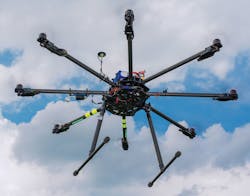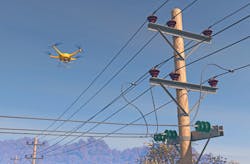John Ivey has flown remote-controlled aircraft for nearly four decades. For the most part, he treated it as a hobby — a chance to touch the sky without ever leaving the ground. But that changed a couple years back when he assisted on the development of a solar field along California’s central coast. Inspecting the installation’s countless photovoltaic (PV) panels took time, and much of the work took place on the ground. As an outsider to the industry, though, he started wondering if there wasn’t a more efficient way to get the work done. What if, he thought, solving the problem was just a matter of finding a fresh perspective?
About that same time, unmanned aerial vehicles (UAVs), or drones, started buzzing around the skies and through the headlines. Just as Amazon CEO Jeff Bezos bragged to CBS News’ Charlie Rose at the beginning of the 2013 Christmas season that Amazon purchases would one day be delivered by a fleet of the UAVs (“I know this looks like science fiction,” the shiny-domed billionaire bragged. “But it’s not.”), shoppers were buying up smaller versions to put under their Christmas trees.
Ivey was well aware of the tech’s rise in popularity — today he owns six drones — and its expanding capabilities. Chief among them: You could strap a Go-Pro to one of the units before sending it aloft, turning it into a literal eye in the sky. And then there was the cost of operation. Hiring a helicopter to survey anything from the air or to record footage can run you upwards of $1,000 an hour. With a drone’s low cost of ownership, though, the hourly rate for that same kind of work could be just a fraction of the cost. That’s when Ivey started putting two and two together: Owners and operators of large PV arrays may not have known it then, but one day very soon they were going to benefit greatly from drones — or from anyone who knew how to fly them.
Getting right with the law
It should come as no surprise that the government — particularly the Federal Aviation Administration (FAA), which regulates civilian airspace — has been slow to adapt to the brave new world of UAV operation. While it’s debatable that anyone could have predicted the meteoric rise of drones, the bureaucratic foot-dragging that has taken place since the FAA began to look at the issue is black and white.
Ironically, in February 2012 — more than 18 months before Bezos turned “drone” into a buzzword synonymous with the “future of the United States economy” — the administration passed the FAA Modernization and Reform Act (FMRA), which sought to, among other things, find ways to safely integrate the technology in the national airspace. The goal was to have a set of laws for governing the commercial use of drones by September 2015. But while the FAA released its proposed rules in February of that year, it’s likely they won’t be finalized until summer 2016, nearly a year late. “No one is satisfied with how fast they’re working,” says Michael Drobac, of the Small UAV Coalition, an industry advocacy group. “Now, are there reasons that they’re not [moving more quickly]? Are there valid concerns that they want to address that would explain why they’re moving slowly? Yes.”
But if you’ve paid attention to the news — or looked skyward even occasionally — you’re likely aware that the lack of an official FAA ruling hasn’t prevented the public from taking to the air on remote-controlled wings. Put simply, drones exist in a legal gray area at the moment. Hobbyists can fly them — provided they stay at least five miles from an airport and ascend no higher than 400 feet above ground level. Commercial operators, on the other hand, must navigate a much trickier set of rules and regulations. First, they must apply for and obtain an exemption based on Section 333 of the FMRA, more commonly known as a Section 333 exemption. Then there’s the certificate of waiver or authorization, which lays out precisely where, when, and how high — in most cases no more than 200 feet — an operator may fly a drone.
[Click to see a PDF version of the UAS Cost Components Chart]
It was into that nebulous regulatory environment that Ivey strode two and a half years ago. “None of us — and I’ve flown with hundreds of guys — knew of any FAA requirement one way or another,” he says. “We just kind of flew with common sense.”
As soon as he heard that he needed an exemption, he applied. That was in November 2014. He finally got his approval five months later, in the first week of April 2015, and his company, Monterey Drones, was born.
The bulk of Ivey’s work consists of taking aerial photography for agriculture, real estate, and sports clients; inspecting PV arrays was merely an afterthought, but it’s one to which he’s beginning to give much more thought these days. “We are actually doing the most feeble marketing at this time,” he says a little sheepishly. “It’s still a very fledgling business.”
Others, like Jon Budreski of Montpelier, Vt.-based AirShark, are taking a much more deliberate approach to selling their services to the owners of large solar farms. Budreski worked in the industry for nearly eight years before he saw the opportunity for marrying his knowledge of photovoltaics with his interest in drones. In the beginning, he had lofty goals of manufacturing and selling UAVs with mapping technology that could be used to design PV systems from the ground up. With investor dollars in short supply, though, he and his partners decided to pivot: Rather than turn their proprietary technology into a product for sale, they’d use it to get into the operations and maintenance business by offering mapping and inspection services to owners. “We thought, ‘If we can fly a drone over a building or a field and map it out beforehand, during, and after construction, we could offer a lot of benefits quickly and more safely than what’s done today,’” Budreski says.
It’s the prospect of offering inspection services that has him looking toward the future. “We can safely get up there, zoom around, and do 10 acres in under 10 minutes,” he says. “On the other hand, it might take two guys walking between rows of panels 12 hours.”
Further complicating matters is what they’re looking for. Even the slightest shifts and heaves in the ground beneath PV arrays can put pressure on an entire rack, which then puts pressure on individual cells. Over time, that pressure can result in microcracks. “And those microcracks don’t allow power to move between cells,” Budreski explains. “So hot spots develop on those diodes.”
The cracks may be imperceptible to the naked eye, but a drone equipped with a thermographic camera can pick them up in high-resolution footage that can be recorded, played back, zoomed in on, and pored over alongside the array’s power output data — “which is something that could be useful when it comes to warranties and insurance,” he points out.
That’s an assessment echoed in the Electric Power Research Institute’s 2015 report, “Utilizing Unmanned Aircraft Systems as a Solar Photovoltaics Operations and Maintenance Tool”: “Performing IR inspection via manned aircraft flyovers on a regular basis is also largely cost prohibitive. As a result, asset owners tend to authorize one-time inspections during the year prior to the expiration of module warranties in order to address any detected issues via warranty claims. However, [UAVs], by virtue of their design and operation, offer the potential to execute IR inspections more often, comprehensively, and cost-effectively.”
In other words, if those asset owners aren’t willing to conduct their own inspections, then they’re leaving the door open for contractors who are.
Untapped potential
Research firm Frost & Sullivan estimates that the market for nonmilitary drones has already reached $2.5 billion worldwide and could continue climbing to $10.8 billion within five years. Navigant Research offers similar growth expectations, putting projections for the next decade at $16.2 billion (see Drone Investments Expected to Soar). EPRI’s report acknowledges that UAV-assisted solar array inspections are still just a niche market. But with firms like Monterey Drone and AirShark popping up across the country — not to mention manufacturers getting into the game with products designed for conducting aerial inspections — it’s becoming increasingly apparent that the market won’t stay niche forever.
As of late February 2016, the FAA had granted more than 3,600 Section 333 exemptions. Of those, less than 20 were specifically for solar-related work — which, to be fair, isn’t a lot. But that number can be read a couple of different ways. On one hand, there may just not be much demand for such a service yet. John Ivey of Monterey Drone has more or less been doing inspections gratis as he waits for his clients to wise up to the tech’s potential. (Think of it as a “The first one’s free, but the next one will cost you” sales technique.)
[Click to see a PDF version of Selected UAS Applications]
Budreski gets people in the door by selling them on his ability to take pretty pictures and videos. “They just want sales and marketing support,” he says of many solar operators. “They don’t realize the potential for what we can do with mapping and thermal imaging. So we’re taking a low-pressure sales approach.”
At the other end of the spectrum is Greenside Energy of Middletown, R.I. Owner Kenneth Alves started as a real estate developer and then graduated to installing a megawatt’s worth of PV arrays — first on his own retail and self-storage developments and later on those built by others. When he discovered UAVs, he saw them as just another tool for the early stages of projects. “We decided to purchase some drones to evaluate roof space to see if it will make for a viable solar project,” Alves says. “Some of the buildings are quite high and not easy to access with a ladder, so it’s much easier to take a photo with a drone. It just streamlines the whole process.”
But this past winter, after a few particularly bad New England snow storms, he discovered that he could also use the technology to inspect his own installations for damage. So not only can he save money by overseeing his own operations and maintenance, but he’s also able to offer it to others. “When solar installations slow down in the next five to six years,” he says, “we plan to offer a lot more O&M.”
Up, up, and away
So it’s possible to look at the low number of operators that currently have Section 333 exemptions for inspecting solar arrays and see a market that has yet to take off. But it’s also possible to see a market that has yet to be taken advantage of. And the only thing standing in the way of that is learning how to fly a drone, filling out the necessary paperwork, and filing it with the FAA. The former is a test of one’s tech savvy; the latter is a test of one’s patience.
Budreski will admit to geeking out about legal processes, so he didn’t mind taking the time to file the petition himself — a seven-page document that not only detailed his plans for AirShark and the exact UAV models he hoped to use, but also safety measures he’d take and the routine maintenance procedures he’d follow. That said, as he and his partners began the process, they found Exemption 333 “consultants” who offered to do the work for them — for a cool $20,000. “That was 12 months ago, and people are learning how to do it themselves,” he says with a chuckle. “So I’ve seen that price come down to between $2,000 and $5,000. But there’s always someone willing to take your money to do a little legal paperwork.”
There’s also always someone willing to flout the rules and fly under the radar. Ivey of Monterey Drone knows of at least two operators near his area who’ve been operating without the necessary clearances. Likewise, Budreski had to wait patiently for the FAA to grant his permit while he watched less scrupulous competitors stake a claim to the market. “Unfortunately, that kind of thing happens,” he says. “You just move on and say, ‘Well, I can report them or deliver better results and act professionally.’”
To that end, it may not be necessary to be the first to get into the drone-assisted inspection game. But for those contractors and installers who’d like to add a service that could be in-demand in the not-too-distant-future, it’s nothing but clear skies ahead.
Halverson is a contributing writer based in Seattle. He can be reached at [email protected].
SIDEBAR: Drone Investments Expected to Soar
According to a recent report from Navigant Research, “Drones and Robotics for Utility Transmission and Distribution” (DRTD), global investment in drones and robotics technologies for transmission and distribution (T&D) systems is expected to reach nearly $16.2 billion by 2024. While unmanned aerial vehicles (UAVs) grow in popularity and increasingly show up in public airspace, the drive to establish commercial uses for the technology is proceeding at a rapid pace. Based on findings from the report, T&D operators and utilities are beginning to examine how UAVs can reduce costs, improve safety, and increase response times across their systems.
“Working on high- and medium-voltage T&D systems is difficult, expensive, and highly dangerous; in fact, a line worker is considered one of the 10 most dangerous occupations in the United States,” says James McCray, senior research analyst with Navigant Research. “While the DRTD market is still at an early stage, there’s a strong motivation in allowing utilities and transmission operators to perform inspections and maintenance without endangering crew members.”
As T&D systems become more interconnected across service territories, the report notes that operational issues can easily cascade across borders, causing larger problems. Maintaining T&D systems is typically a utility’s No. 1 priority, and DRTD technologies can assist in assessing areas to determine where crews should be deployed.


